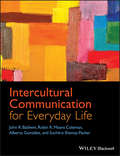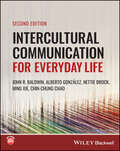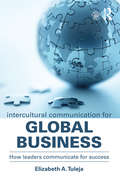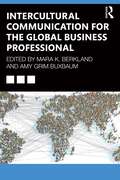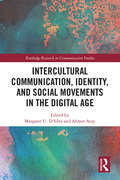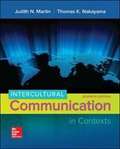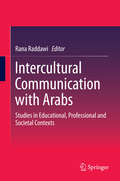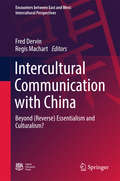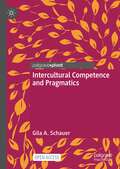- Table View
- List View
Intercultural Communication: A Discourse Approach (Language in Society)
by Ron Scollon Suzanne Wong Scollon Rodney H. JonesThis newly revised edition is both a lively introduction and practical guide to the main concepts and challenges of intercultural communication. Grounded in interactional sociolinguistics and discourse analysis, this work integrates theoretical principles and methodological advice, presenting students, researchers, and practitioners with a comprehensive and unified resource. Features new original theory, expanded treatment of generations, gender and corporate and professional discourse Offers improved organization and added features for student and classroom use, including advice on research projects, questions for discussion, and references at the end of each chapter Extensively revised with newly added material on computer mediated communication, sexuality and globalization
Intercultural Communication and Identity (Elements in Intercultural Communication)
by null Ron Darvin null Tongle SunThis Element asserts how identity as a construct enables a critical awareness of how speakers position themselves and are positioned by others in intercultural encounters. It discusses how identity vis-à-vis culture has been theorized through social psychological, poststructuralist, and critical lenses, and how identity is discursively constructed and mediated. Rejecting essentialist notions of language and culture, this Element demonstrates how inscriptions of identity such as race, ethnicity, nationality, and class can be used to critically examine the dynamics of situated intercultural encounters and to understand how such interactions can index competing and colluding ideologies. By examining identity research from different parts of the world, it casts a light on how identities are performed in diverse intercultural contexts and discusses research methodologies that have been employed to examine identity in intercultural communication.
Intercultural Communication for Everyday Life
by John R. Baldwin Robin R. Coleman Alberto González Suchitra Shenoy-PackerWritten for students studying intercultural communication for the first time, this textbook gives a thorough introduction to inter- and cross-cultural concepts with a focus on practical application and social action. Provides a thorough introduction to inter- and cross-cultural concepts for beginning students with a focus on practical application and social action Defines “communication” broadly using authors from a variety of sub disciplines and incorporating scientific, humanistic, and critical theory Constructs a complex version of culture using examples from around the world that represent a variety of differences, including age, sex, race, religion, and sexual orientation Promotes civic engagement with cues toward individual intercultural effectiveness and giving back to the community in socially relevant ways Weaves pedagogy throughout the text with student-centered examples, text boxes, applications, critical thinking questions, a glossary of key terms, and online resources for students and instructors Online resources for students and instructors available upon publication at www.wiley.com/go/baldwin
Intercultural Communication for Everyday Life
by John R. Baldwin Robin R. Coleman Alberto González Suchitra Shenoy-PackerWritten for students studying intercultural communication for the first time, this textbook gives a thorough introduction to inter- and cross-cultural concepts with a focus on practical application and social action. Provides a thorough introduction to inter- and cross-cultural concepts for beginning students with a focus on practical application and social action Defines “communication” broadly using authors from a variety of sub disciplines and incorporating scientific, humanistic, and critical theory Constructs a complex version of culture using examples from around the world that represent a variety of differences, including age, sex, race, religion, and sexual orientation Promotes civic engagement with cues toward individual intercultural effectiveness and giving back to the community in socially relevant ways Weaves pedagogy throughout the text with student-centered examples, text boxes, applications, critical thinking questions, a glossary of key terms, and online resources for students and instructors Online resources for students and instructors available upon publication at www.wiley.com/go/baldwin
Intercultural Communication for Everyday Life
by John R. Baldwin Alberto González Nettie Brock Ming Xie Chin-Chung ChaoINTERCULTURAL COMMUNICATION FOR EVERYDAY LIFE Face the global challenges of the future with this accessible introduction to communication across boundaries Communication between cultures can be challenging in a number of ways, but it also carries immense potential rewards. In an increasingly connected world, it has never been more important to communicate across a range of differences created by history and circumstance. Contributing to global communities and rising to meet crucial shared challenges—human rights disputes, refugee crises, the international climate crisis—depends, in the first instance, on a sound communicative foundation. Intercultural Communication for Everyday Life provides a thorough introduction to this vital subject for students encountering it for the first time. Built around a robust and multifaceted definition of culture, which goes far beyond simple delineation of national boundaries, it offers an understanding of its subject that transcends US-centricity. The result, updated to reflect dramatic ongoing changes to the interconnected world, is essential for students of cross—cultural communication and exchange. Readers of the second edition of Intercultural Communication for Everyday Life readers will also find: Accessible definitions of core concepts Revised and updated chapters reflecting the COVID-19 crisis, climate change challenges, and more An all-new chapter on social media as a tool for intercultural communication Intercultural Communication for Everyday Life is essential for students and other readers seeking a foundational overview of this subject.
Intercultural Communication for Everyday Life
by John R. Baldwin Alberto González Nettie Brock Ming Xie Chin-Chung ChaoINTERCULTURAL COMMUNICATION FOR EVERYDAY LIFE Face the global challenges of the future with this accessible introduction to communication across boundaries Communication between cultures can be challenging in a number of ways, but it also carries immense potential rewards. In an increasingly connected world, it has never been more important to communicate across a range of differences created by history and circumstance. Contributing to global communities and rising to meet crucial shared challenges—human rights disputes, refugee crises, the international climate crisis—depends, in the first instance, on a sound communicative foundation. Intercultural Communication for Everyday Life provides a thorough introduction to this vital subject for students encountering it for the first time. Built around a robust and multifaceted definition of culture, which goes far beyond simple delineation of national boundaries, it offers an understanding of its subject that transcends US-centricity. The result, updated to reflect dramatic ongoing changes to the interconnected world, is essential for students of cross—cultural communication and exchange. Readers of the second edition of Intercultural Communication for Everyday Life readers will also find: Accessible definitions of core concepts Revised and updated chapters reflecting the COVID-19 crisis, climate change challenges, and more An all-new chapter on social media as a tool for intercultural communication Intercultural Communication for Everyday Life is essential for students and other readers seeking a foundational overview of this subject.
Intercultural Communication for Global Business: How leaders communicate for success
by Elizabeth A. TulejaThis book brings together principles and new theories in intercultural communication in a concise and practical manner, focusing on communication as the foundation for management and global leadership. Grounded in the Cultural Intelligence Model, this compact text examines the concepts associated with understanding culture and communication in the global business environment to help readers: • Understand intercultural communication processes. • Improve self-awareness and communication in intercultural settings. • Expand skills in identifying, analyzing, and solving intercultural communication challenges at work. • Evaluate whether one’s communication has been effective. Richly illustrated with examples, activities, real-world applications, and recent case studies that make the content come alive, Intercultural Communication for Global Business is an ideal companion for any business student or manager dedicated to communicating more effectively in a globalized society.
Intercultural Communication for Global Business: How leaders communicate for success
by Elizabeth A. TulejaThis book brings together principles and new theories in intercultural communication in a concise and practical manner, focusing on communication as the foundation for management and global leadership. Grounded in the Cultural Intelligence Model, this compact text examines the concepts associated with understanding culture and communication in the global business environment to help readers: • Understand intercultural communication processes. • Improve self-awareness and communication in intercultural settings. • Expand skills in identifying, analyzing, and solving intercultural communication challenges at work. • Evaluate whether one’s communication has been effective. Richly illustrated with examples, activities, real-world applications, and recent case studies that make the content come alive, Intercultural Communication for Global Business is an ideal companion for any business student or manager dedicated to communicating more effectively in a globalized society.
Intercultural Communication for Global Business: How Leaders Communicate for Success
by Elizabeth A. TulejaAs concise and practical as ever, this new edition brings together principles and new theories in intercultural communication, focusing on communication as the foundation for management and global leadership. Grounded in the need for building awareness and knowledge, practicing mindfulness, and then working on skill development, this text examines the concepts associated with understanding culture and communication in the global business environment to help readers: understand intercultural communication processes; improve self-awareness and communication in intercultural settings; expand skills in identifying, analyzing, and solving intercultural communication challenges at work; and evaluate whether one’s communication has been effective. This fully updated new edition also includes completely updated case studies, with an increased emphasis on non-US perspectives, to show real-world applications across the globe. Richly illustrated with new examples and activities, this text is the ideal companion for any business student or manager dedicated to communicating more effectively in a globalized society.
Intercultural Communication for Global Business: How Leaders Communicate for Success
by Elizabeth A. TulejaAs concise and practical as ever, this new edition brings together principles and new theories in intercultural communication, focusing on communication as the foundation for management and global leadership. Grounded in the need for building awareness and knowledge, practicing mindfulness, and then working on skill development, this text examines the concepts associated with understanding culture and communication in the global business environment to help readers: understand intercultural communication processes; improve self-awareness and communication in intercultural settings; expand skills in identifying, analyzing, and solving intercultural communication challenges at work; and evaluate whether one’s communication has been effective. This fully updated new edition also includes completely updated case studies, with an increased emphasis on non-US perspectives, to show real-world applications across the globe. Richly illustrated with new examples and activities, this text is the ideal companion for any business student or manager dedicated to communicating more effectively in a globalized society.
Intercultural Communication for the Global Business Professional
by Mara K. Berkland Amy Grim BuxbaumThis text integrates business and communication concepts to immerse students in the global communication experiences of business professionals. The authors argue that the essentials of intercultural communication, such as nonverbal communication, conflict, meeting management, interviewing, and negotiations are most useful to burgeoning professionals when they are woven into discussions about economic systems, market forces, production processes, finance structures, and human resources priorities. Each chapter begins with an explanation of theories and key terms appropriate for introductory-level students in both business and communication, then supplements that discussion with examples that demonstrate the concepts at work. The cases chosen represent different market systems in both dominant and emerging economies, explaining the cultures of competitive markets with a global perspective rather than focusing on the United States. This book is ideal as a text for courses in international business or professional intercultural communication, or as a supplement for more general business and communication courses.
Intercultural Communication for the Global Business Professional
This text integrates business and communication concepts to immerse students in the global communication experiences of business professionals. The authors argue that the essentials of intercultural communication, such as nonverbal communication, conflict, meeting management, interviewing, and negotiations are most useful to burgeoning professionals when they are woven into discussions about economic systems, market forces, production processes, finance structures, and human resources priorities. Each chapter begins with an explanation of theories and key terms appropriate for introductory-level students in both business and communication, then supplements that discussion with examples that demonstrate the concepts at work. The cases chosen represent different market systems in both dominant and emerging economies, explaining the cultures of competitive markets with a global perspective rather than focusing on the United States. This book is ideal as a text for courses in international business or professional intercultural communication, or as a supplement for more general business and communication courses.
Intercultural Communication, Identity, and Social Movements in the Digital Age (Routledge Research in Communication Studies)
by Margaret U. D'Silva Ahmet AtayThis book examines the complex and multidimensional relationship between culture and social media, and its specific impact on issues of identity and social movements, in a globalized world. Contemporary cyber culture involves communication among people who are culturally, nationally, and linguistically similar or radically different. Social media becomes a space for mediated cultural information transfer which can either facilitate a vibrant public sphere or create cultural and social cleavages. Contributors of the book come from diverse cultural backgrounds to provide a comprehensive analysis of how these social media exchanges allow members of traditionally oppressed groups find their voices, cultivate communities, and construct their cultural identities in multiple ways.This book will be of great relevance to scholars and students working in the field of media and new media studies, intercultural communication, especially critical intercultural communication, and academics studying social identity and social movements.
Intercultural Communication, Identity, and Social Movements in the Digital Age (Routledge Research in Communication Studies)
by Margaret U. D’Silva; Ahmet AtayThis book examines the complex and multidimensional relationship between culture and social media, and its specific impact on issues of identity and social movements, in a globalized world. Contemporary cyber culture involves communication among people who are culturally, nationally, and linguistically similar or radically different. Social media becomes a space for mediated cultural information transfer which can either facilitate a vibrant public sphere or create cultural and social cleavages. Contributors of the book come from diverse cultural backgrounds to provide a comprehensive analysis of how these social media exchanges allow members of traditionally oppressed groups find their voices, cultivate communities, and construct their cultural identities in multiple ways.This book will be of great relevance to scholars and students working in the field of media and new media studies, intercultural communication, especially critical intercultural communication, and academics studying social identity and social movements.
Intercultural Communication in Asia: Education, Language and Values (Multilingual Education #24)
by Andy Curtis Roland SussexThis volume presents in-depth studies on leading themes in education policy and intercultural communication in contemporary Asia, covering empirical as well as theoretical approaches, and offering both an in-depth investigation of their implications, and a synthesis of areas where these topics cohere and point to advances in description, analysis and theory, policy and applications. The studies address key questions that are essential to the future of education in an Asia where intercultural communication is ever more important with the rise of the ASEAN Economic Community and other international initiatives. These questions include the properties of the increasing globalisation of communication and how it plays out in Asia, especially but not exclusively with reference to English, and how we can place intercultural communication in this context, as well as studies that highlight intercultural communication and its underlying value systems and ideologies in Asia.
Intercultural Communication in Contexts (Seventh edition) (PDF)
by Judith Martin Thomas NakayamaThe 7th edition of Intercultural Communication in Contexts examines communication in multicultural relationships and provides the tools for effective communication amid cultural, ethnic, and religious differences in domestic and global contexts. Students are introduced to the primary approaches for studying intercultural communication along with a theoretical and practical framework for applying the approaches in their own lives. The varied backgrounds of coauthors Judith N. Martin, a social scientist, and Thomas K. Nakayama, a critical rhetorician, bring a unique viewpoint to the subject matter. The Connect course for this offering includes SmartBook, an adaptive reading and study experience which guides students to master, recall, and apply key concepts while providing automatically-graded assessments.
Intercultural Communication in Interpreting: Power and Choices
by Jinhyun ChoNavigating and resolving issues in intercultural communication is an integral part of the interpreter’s role on a daily basis. This book is an essential guide to the interpersonal dimensions of intercultural communication in a variety of key interpreting contexts: business, education, law, and healthcare. Drawing on the unique perspectives of professional interpreters, Cho focuses on two key questions that remain underexamined in the field of intercultural communication: why does intercultural communication often break down, and how do individuals manage intercultural communication issues? Each chapter deals with issues pertinent to small cultural aspects of intercultural communication, including gender, ethnic migrant communities, educational cultures among migrants of Asian backgrounds, and monolingualism/monoculturalism in courtroom and refugee interview contexts. Spanning diverse geographical domains, the book highlights the impact of macro power on interpreting as well as the significance of individual agency and micro power, which can rebalance the given communicative context. Offering a comprehensive, up-to-date, innovative, and critical perspective on intercultural communication in interpreting, this is key reading for student and professional interpreters and those on courses in language and intercultural communication.
Intercultural Communication in Interpreting: Power and Choices
by Jinhyun ChoNavigating and resolving issues in intercultural communication is an integral part of the interpreter’s role on a daily basis. This book is an essential guide to the interpersonal dimensions of intercultural communication in a variety of key interpreting contexts: business, education, law, and healthcare. Drawing on the unique perspectives of professional interpreters, Cho focuses on two key questions that remain underexamined in the field of intercultural communication: why does intercultural communication often break down, and how do individuals manage intercultural communication issues? Each chapter deals with issues pertinent to small cultural aspects of intercultural communication, including gender, ethnic migrant communities, educational cultures among migrants of Asian backgrounds, and monolingualism/monoculturalism in courtroom and refugee interview contexts. Spanning diverse geographical domains, the book highlights the impact of macro power on interpreting as well as the significance of individual agency and micro power, which can rebalance the given communicative context. Offering a comprehensive, up-to-date, innovative, and critical perspective on intercultural communication in interpreting, this is key reading for student and professional interpreters and those on courses in language and intercultural communication.
Intercultural Communication in the Chinese Workplace
by Ping Du D. PingThis book proposes a new theoretical and methodological approach to the investigation and explanation of intercultural differences in conflict management strategies and relational (politeness) strategies in workplace settings, taking the Chinese workplace as its focus.
Intercultural Communication with Arabs: Studies in Educational, Professional and Societal Contexts
by Rana RaddawiThis book features 18 essays that explore the ways people communicate in the Arab world, from the Unites Arab Emirates to Qatar, Saudi Arabia to Oman. While there is a concentration of studies from the Gulf Arab states, the collection spans perspectives from Iraq, Syria, Lebanon, Egypt, Libya, Tunisia, and Sudan. Written by both Arab authors and foreign scholars who live or have lived in the region, it will help readers to better understand and communicate with Arab culture and society.The book is divided into three main sections that include studies in educational, professional, and societal contexts. Based on ethnographies, case studies, and real life experiences, the essays provide insight into the ways Arabs communicate in different situations, contexts, and settings such as business, education, politics, media, healthcare, and society at large.Drawing on current theory, research, and practice, this book will help readers better understand and, as a result, better engage with the Arab world.
Intercultural Communication with China: Beyond (Reverse) Essentialism and Culturalism? (Encounters between East and West)
by Fred Dervin Regis MachartA major objective of this book is to identify the key determinants of the “East” and the “West” in the field of intercultural communication. It examines but also counter-attacks essentialist and culturalist analyses of intercultural communication between China and the rest of the world. Offering a cross-country examination and comparison of drought awareness and experience, this book shows two fields of research, which are complementary but rarely found side by side, i.e. the Arts and Intercultural Encounters, serve as illustrations for theoretical and methodological discussions about intercultural communication between China and the West. Scholarly and media discourses will find this work thought-provoking, instructive and informative.
Intercultural Communicative Competence for Global Citizenship: Identifying cyberpragmatic rules of engagement in telecollaboration
by Marina Orsini-Jones Fiona LeeThis work builds on the assumption that language learning and teaching needs to be made more relevant to the 'glocalised' digital world we live in. Its authors argue that staff in Higher Education (HE) must prepare students for effective online interaction and explores the digital, linguistic and critical intercultural components of ‘global citizenship’. The book pivots around an innovative research study; linguistic politeness frameworks are revisited to analyse the written online exchanges on an Online International Learning (OIL) - or intercultural telecollaborative - project between the UK and France.Through the use of cyberpragmatics, and inspired by Meyer and Land’s ‘threshold concept pedagogy’, the authors examine the challenges and solutions identified by an ‘expert student’ in managing rules of engagement and intercultural awareness when interacting online. This book will appeal to students and scholars of applied linguistics, education, sociolinguistics and intercultural communication, and provide a valuable resource for teacher trainers, language teachers and educators across the world.
Intercultural Competence and Pragmatics
by Gila A. SchauerThis Open Access book examines the link between intercultural competence (IC) and pragmatics by asking frontline modern foreign language teachers in higher education teaching a variety of languages (e.g., Dutch, English, French, German, Italian, Spanish, Swedish) how they conceptualise intercultural competence and which skills, competences and knowledge they consider important in their teaching contexts. The data were collected with an online survey that focused on the relationship between intercultural competence and pragmatics.While international organizations such as the United Nations Educational, Scientific and Cultural Organization (UNESCO) or the Council of Europe (CoE) agree that intercultural competence should play an important role in education, it is not always clear what IC may encompass in specific teaching contexts and subject areas. Examining how modern foreign language teachers in higher education conceptualise intercultural competence and the value they attach as well as the attention they give to various areas of pragmatics in their teaching is highly important, since those language professionals may be the final teachers learners encounter during their formal foreign language education. They are therefore in a unique position to shape modern foreign language learners’ intercultural and pragmatic awareness, competence and skills.This book will be of interest to language professionals, modern foreign language teachers and teacher trainers, as well as students and scholars of applied linguistics, pragmatics, and language education.
Intercultural Competence for Translators
by Daniel Tomozeiu Kaisa Koskinen Adele D'ArcangeloBy definition, translators are intercultural mediators. This book explores some of the most important current approaches in defining intercultural competence for translators. At the same time, it provides real-life examples of different approaches in operationalizing intercultural competence and teaching it in a translator-training context. Written for a global audience, the book provides an informative overview of the field as well as practical examples from different academic and cultural contexts. This book was originally published as a special issue of The Interpreter and Translator Trainer.
Intercultural Competence for Translators
by Daniel Tomozeiu Kaisa Koskinen Adele D’ArcangeloBy definition, translators are intercultural mediators. This book explores some of the most important current approaches in defining intercultural competence for translators. At the same time, it provides real-life examples of different approaches in operationalizing intercultural competence and teaching it in a translator-training context. Written for a global audience, the book provides an informative overview of the field as well as practical examples from different academic and cultural contexts. This book was originally published as a special issue of The Interpreter and Translator Trainer.


